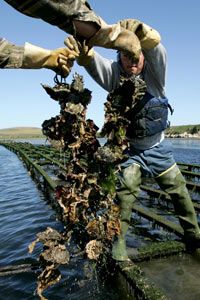How Toxic Shellfish Get That Way
Dinoflagellates are a family of single-celled organisms that heavily populate the ocean. They clump together and float near the surface, allowing ocean currents to dictate their travels. Some dinoflagellates use photosynthesis to transform sunlight into energy, while others are capable of producing their own light. These tiny life forms are the perfect food for shellfish: delicious, nutritious and, most importantly, tiny enough to be filtered between shells.
Dinoflagellates reproduce in great numbers during the summer, and sometimes the population explosion produces so many of these tiny organisms that the water takes on a reddish tint. This is known as a red tide. People have long associated shellfish poisoning with red tides, even though researchers don't fully understand the connection between the two. Furthermore, toxic dinoflagellates can be present without the visual presence of a red tide, and there can be a visible red tide without the presence of toxic dinoflagellates, so it doesn't seem to be a reliable indicator.
Advertisement
What does seem to matter is what the dinoflagellates themselves have been dining on. Dinoflagellates sometimes consume toxic alkaloids called saxitoxins. The type of saxitoxin the dinoflagellate consumes determines what type of shellfish poisoning you'll receive at your lofty position atop the food chain.
The bad news is that once a shellfish becomes toxic, no amount of heat during cooking will destroy the bacteria. Because of this, you should definitely not harvest your own shellfish during months with an "R" in them, especially along the Pacific Coast. This activity is banned in the state of California (and restricted elsewhere) between May and October because the toxin responsible for paralytic shellfish poisoning is more prevalent during those months. Generally speaking, however, the major downside to summertime oysters is the disappointment you may feel upon eating them -- bivalves reproduce in the summertime and most of their energy goes toward this endeavor, leaving the meat somewhat scrawny.
The good news is that precautions taken during the raising and harvesting of commercial shellfish make them safe to eat any time of the year. So long as your shellfish has been commercially harvested and no advisories have been issued by state governments or the U.S. Department of Health, you should rest easy knowing your shellfish is safe to enjoy.
Want to see more old wives' tales debunked? See the next page.
Related HowStuffWorks Articles
- Does sucking your thumb really ruin your teeth?
- Does stress really make your hair go gray faster?
- Will an apple a day really keep the doctor away?
- Is eating bread crust really good for you?
- 5 Old Wives' Tales about Your Health
- If you step on a rusty nail will you really get tetanus?
- Should you really starve a fever?
- Is it true that if you do anything for three weeks it will become a habit?
Sources
- Arnold, Thomas, MD. "Toxicity, Ciguatera." June 7, 2007. (July 13, 2009)http://emedicine.medscape.com/article/813869-overview
- Arnold, Thomas, MD. "Toxicity, Shellfish." June 7, 2007. (July 9, 2009)http://emedicine.medscape.com/article/818505-overview
- Assure Controls. "All About Dinoflagellates." (July 14, 2009)http://www.assurecontrols.com/info-dinoflagellates.htm
- Fleming, Lora E. "Amnesic Shellfish Poisoning. NIEHS Marine and Freshwater Biomedical Sciences Center. May 7, 2008.http://www.whoi.edu/redtide/page.do?pid=9679&tid=523&cid=27686
- Harstine Oyster Company. (July 15, 2009)http://www.salishseafoods.com/
- Massachusetts Office of Health and Human Services. "Red Tide Fact Sheet." July 14, 2009. http://www.mass.gov/?pageID=eohhs2modulechunk&L=4&L0=Home&L1=Provider&L2=Guidance+for+Businesses&L3=Food+Safety&sid=Eeohhs2&b=terminalcontent&f=dph_environmental_foodsafety_p_red_tide&csid=Eeohhs2
- MedlinePlus. "Poisoning - fish and shellfish." Jan. 30, 2009. (July 9, 2009)http://www.nlm.nih.gov/medlineplus/ency/article/002851.htm
- Ohio Department of Health. "Fact Sheet: Shellfish toxins." (July 9, 2009)http://www.odh.ohio.gov/pdf/foodrecall/fddefine/shellfish.pdf
- Pledger, David, MD. "Toxicity, Seafood." June 21, 2006.http://emedicine.medscape.com/article/1011549-overview
- University of California Museum of Paleontology. "Introduction to the Dinoflagellata." (July 9, 2009) http://www.ucmp.berkeley.edu/protista/dinoflagellata.html
- U.S. National Office for Harmful Algal Blooms. "Harmful Algae."http://www.whoi.edu/redtide/page.do?pid=9257
- Washington State Department of Health. "Paralytic Shellfish Poisoning ("red tide")." Mar. 5, 2009. (July 14, 2009)http://www.doh.wa.gov/ehp/sf/Pubs/PSPfactSheet.htm
- Washington Department of Fish and Wildlife. "Shellfish." (July 16, 2009)http://wdfw.wa.gov/fish/shelfish/beachreg/3clam.htm
